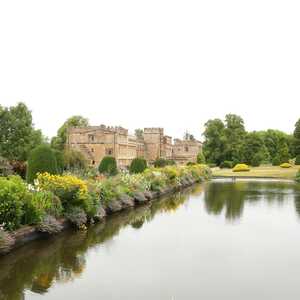THE GARDENS
Home to the highest powered fountain in the country, the award-winning gardens include topiary-lined vistas, colourful herbaceous borders, an arboretum, and a bog garden, which together with swathes of early Spring bulbs and camellias provide all year-round interest. Designed to incorporate both the formal and informal aspects of garden design, the straight lines give way to meandering pathways the further you head away from the house, with plenty of benches and seating to admire the views along the way.
A garden is never the finished article, but more like a chapter that is constantly being written, re-written and edited to shape the flow and style of the narrative. It has slowly evolved over 900 years to reflect the lifestyle and taste of each generation living here.

A BRIEF HISTORY
The early Cistercian monks would have farmed the land and grown seasonal fruit and vegetables in accordance with a strict vegetarian diet. Today, the only monastic structure that remains in the garden is the Great Pond, used for a practical rather than aesthetic purpose to power a mill on the site of the present day Forge.
FORMAL LAYOUT
Sir Francis Gwyn created the beginnings of the modern garden during the early 18th-century. Gwyn used the water from the Great Pond to create the connecting three lower ponds while also laying out the lawns and drives and, in keeping with the design principles of the day, incorporating great yews and limes to lead the eye along significant views and vistas.

THE WALLED GARDEN
The Evans family bought the Abbey and estate in 1864 and under their stewardship the garden at Forde Abbey was of typical Victorian design, with the extensive walled garden to the north and dark shrubberies to the South. Summer bedding provided the colour to frame the house but the garden was very labour intensive and even at the outbreak of the First World War required ten full time gardeners to maintain it.
FURTHER ADDITIONS
Using the legacy of the eighteenth-century landscape and the nineteenth-century trees, three generation of the Roper family were responsible for establishing the Bog Garden, Park Garden and Rock Garden and during his lifetime, Geoffrey Roper planted more than 350,000 trees on the estate.
Proud Members
We're proud to be members of RHS Partner Gardens and The Great Garden Trail of Dorset.















